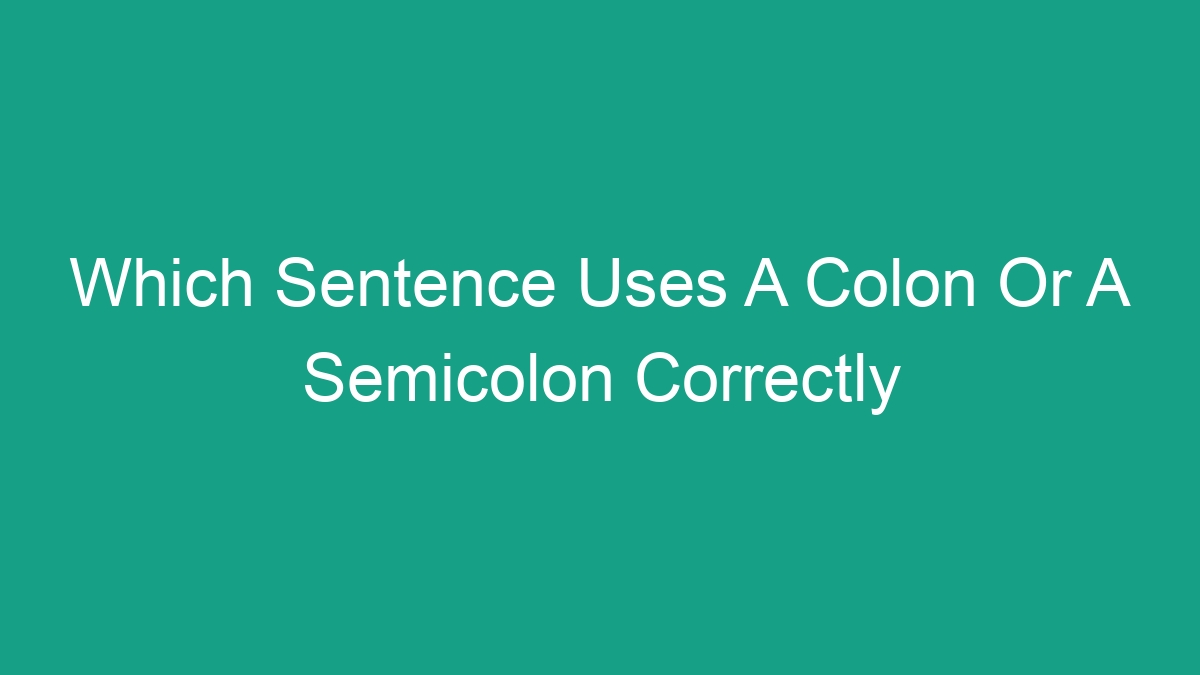
Welcome to our guide on the proper use of colons and semicolons in sentences. Many writers find punctuation to be a tricky aspect of writing, and colons and semicolons are no exception. However, understanding the correct usage of these punctuation marks can significantly improve the clarity and effectiveness of your writing. In this article, we will discuss the differences between colons and semicolons and provide clear examples of their proper usage.
Understanding Colons
A colon is a punctuation mark consisting of two equally sized dots that are placed vertically and separated by the same amount of space. It is used to introduce a list, a quotation, an explanation, or a conclusion. Here are the primary ways in which colons are used:
- To introduce a list: When you want to introduce a list of items, the colon is used to signal that the list is about to begin. For example, “I need to buy three items from the store: bread, milk, and eggs.”
- To introduce a quotation: Colons are used to introduce a quotation that follows an independent clause. For instance, “The famous author once said: ‘The only way to do great work is to love what you do.'”
- To introduce an explanation or a conclusion: A colon can be used to introduce an explanation or a conclusion that follows an independent clause. For example, “She had one goal in mind: to make a positive impact on the world.”
Understanding Semicolons
A semicolon is a punctuation mark that is used to connect two independent clauses that are closely related. It is also used to separate items in a list when the items themselves contain commas. Here are the primary ways in which semicolons are used:
- To connect closely related independent clauses: When two independent clauses are closely related and are not joined by a coordinating conjunction (such as and, but, or, nor, for, so, yet), a semicolon can be used to connect them. For example, “She was late; the meeting had already started.”
- To separate items in a list with internal punctuation: Semicolons can be used to separate items in a list when the items themselves contain commas. For instance, “The conference will include representatives from New York, New York; Los Angeles, California; and San Francisco, California.”
Examples of Correct Usage
Now that we have a clear understanding of the proper usage of colons and semicolons, let’s look at some examples of correct usage:
| Colons | Semicolons |
|---|---|
| “There are three things I love: reading, writing, and traveling.” | “She had been practicing for months; she was determined to win the competition.” |
| “He quoted the famous philosopher: ‘The only thing necessary for the triumph of evil is for good men to do nothing.'” | “The students were excited; they were going on a field trip to the zoo.” |
| “Her goal was simple: to inspire others to pursue their dreams.” | “The menu included a variety of options: grilled chicken, salmon, and vegetable stir-fry.” |
Common Mistakes to Avoid
When it comes to using colons and semicolons, there are a few common mistakes that writers should be aware of:
- Using a colon after a preposition: It is incorrect to use a colon immediately after a preposition (e.g., She had three reasons for being late: because of traffic.). In this case, a comma or no punctuation at all would be more appropriate.
- Using a semicolon to join an independent clause and a dependent clause: Semicolons should only be used to connect independent clauses. Using a semicolon to join an independent clause and a dependent clause is grammatically incorrect (e.g., They arrived late; because their train was delayed.). In this case, a comma or a period would be more appropriate.
FAQs
Q: Can a colon be used after a question?
A: Yes, a colon can be used after a question when the sentence before the colon is a complete sentence and the words after the colon provide an answer or explanation to the question.
Q: Can a semicolon be used to join two sentences without a conjunction?
A: Yes, a semicolon can be used to join two closely related sentences without using a conjunction. This is often done to show a stronger connection between the two sentences.
Q: Is it acceptable to use a colon and a semicolon in the same sentence?
A: Yes, it is acceptable to use both a colon and a semicolon in the same sentence if the punctuation marks serve different purposes and are used correctly.
Q: When should I use a comma instead of a semicolon?
A: A comma is used to separate items in a list or to join independent clauses with a coordinating conjunction. A semicolon, on the other hand, is used to join independent clauses without a coordinating conjunction or to separate items in a list when the items themselves contain commas.
With a clear understanding of when to use a colon or a semicolon, writers can effectively enhance the structure and readability of their writing. By practicing the proper usage of these punctuation marks, writers can convey their ideas more effectively and improve the overall quality of their writing.




